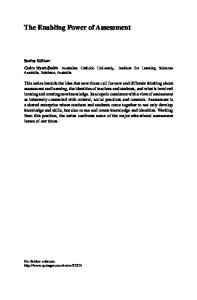The Creative Learning Spiral: Designing Environments for Flaring and Focusing
With growing interest in creative learning in recent years, this paper sought to define creative learning through the design of learning spaces. Two learner groups were studied for their interactions with peers, educators, and their spaces—design students
- PDF / 11,491,396 Bytes
- 330 Pages / 453.543 x 683.15 pts Page_size
- 83 Downloads / 330 Views
acher Transition into Innovative Learning Environments A Global Perspective
Teacher Transition into Innovative Learning Environments
Wesley Imms Thomas Kvan •
Editors
Teacher Transition into Innovative Learning Environments A Global Perspective
123
Editors Wesley Imms The University of Melbourne Parkville, VIC, Australia
Thomas Kvan The University of Melbourne Parkville, VIC, Australia
ISBN 978-981-15-7496-2 ISBN 978-981-15-7497-9 https://doi.org/10.1007/978-981-15-7497-9
(eBook)
© The Editor(s) (if applicable) and The Author(s) 2021. This book is an open access publication. Open Access This book is licensed under the terms of the Creative Commons Attribution 4.0 International License (http://creativecommons.org/licenses/by/4.0/), which permits use, sharing, adaptation, distribution and reproduction in any medium or format, as long as you give appropriate credit to the original author(s) and the source, provide a link to the Creative Commons license and indicate if changes were made. The images or other third party material in this book are included in the book’s Creative Commons license, unless indicated otherwise in a credit line to the material. If material is not included in the book’s Creative Commons license and your intended use is not permitted by statutory regulation or exceeds the permitted use, you will need to obtain permission directly from the copyright holder. The use of general descriptive names, registered names, trademarks, service marks, etc. in this publication does not imply, even in the absence of a specific statement, that such names are exempt from the relevant protective laws and regulations and therefore free for general use. The publisher, the authors and the editors are safe to assume that the advice and information in this book are believed to be true and accurate at the date of publication. Neither the publisher nor the authors or the editors give a warranty, expressed or implied, with respect to the material contained herein or for any errors or omissions that may have been made. The publisher remains neutral with regard to jurisdictional claims in published maps and institutional affiliations. This Springer imprint is published by the registered company Springer Nature Singapore Pte Ltd. The registered company address is: 152 Beach Road, #21-01/04 Gateway East, Singapore 189721, Singapore
Preface
Occasionally, events in research conspire to move our thinking ahead with a jolt. This book is an outcome of such serendipitous events. For more than a decade the Learning Environments Applied Research Network (LEaRN) from The University of Melbourne’s faculties of Education and Architecture conducted high-level research projects, many for the Australian Research Council. Each added another layer of knowledge to what we knew about good design and use of learning environments in schools, hospitals and the like. These were always done in consultation with relevant industry groups, but its Innovative Learning Environments and Teacher Change (ILETC) project leveraged those accomplish
Data Loading...











